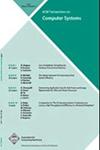S2E平台:设计、实现和应用
IF 1.8
4区 计算机科学
Q2 COMPUTER SCIENCE, THEORY & METHODS
引用次数: 184
摘要
本文介绍了S2E,一个用于分析软件系统属性和行为的平台,以及它在开发工具中的用途,这些工具用于全面的性能分析、专有软件的逆向工程以及对内核模式和用户模式二进制文件的自动化测试。从概念上讲,S2E是一个带有模块化路径分析器的自动化路径资源管理器:资源管理器使用符号执行引擎驱动目标系统沿着所有感兴趣的执行路径运行,而分析器则测量和/或检查每个路径的属性。S2E用户可以组合现有的分析工具来构建定制的分析工具,也可以直接使用S2E的api。S2E的优势在于能够扩展到大型系统,例如完整的Windows堆栈,使用两个新思想:选择性符号执行,一种自动减少必须在目标分析中以符号方式执行的代码量的方法,以及执行一致性模型,一种在分析过程中进行性能/准确性折衷的方法。这些技术赋予S2E三个关键能力:同时分析整个执行路径族,而不是一次只分析一个执行;在真实的软件堆栈(用户程序、库、内核、驱动程序等)中执行活体分析,而不是使用这些层的抽象模型;并直接操作二进制文件,从而能够分析甚至专有软件。本文章由计算机程序翻译,如有差异,请以英文原文为准。
The S2E Platform: Design, Implementation, and Applications
This article presents S2E, a platform for analyzing the properties and behavior of software systems, along with its use in developing tools for comprehensive performance profiling, reverse engineering of proprietary software, and automated testing of kernel-mode and user-mode binaries. Conceptually, S2E is an automated path explorer with modular path analyzers: the explorer uses a symbolic execution engine to drive the target system down all execution paths of interest, while analyzers measure and/or check properties of each such path. S2E users can either combine existing analyzers to build custom analysis tools, or they can directly use S2E’s APIs.
S2E’s strength is the ability to scale to large systems, such as a full Windows stack, using two new ideas: selective symbolic execution, a way to automatically minimize the amount of code that has to be executed symbolically given a target analysis, and execution consistency models, a way to make principled performance/accuracy trade-offs during analysis. These techniques give S2E three key abilities: to simultaneously analyze entire families of execution paths instead of just one execution at a time; to perform the analyses in-vivo within a real software stack---user programs, libraries, kernel, drivers, etc.---instead of using abstract models of these layers; and to operate directly on binaries, thus being able to analyze even proprietary software.
求助全文
通过发布文献求助,成功后即可免费获取论文全文。
去求助
来源期刊

ACM Transactions on Computer Systems
工程技术-计算机:理论方法
CiteScore
4.00
自引率
0.00%
发文量
7
审稿时长
1 months
期刊介绍:
ACM Transactions on Computer Systems (TOCS) presents research and development results on the design, implementation, analysis, evaluation, and use of computer systems and systems software. The term "computer systems" is interpreted broadly and includes operating systems, systems architecture and hardware, distributed systems, optimizing compilers, and the interaction between systems and computer networks. Articles appearing in TOCS will tend either to present new techniques and concepts, or to report on experiences and experiments with actual systems. Insights useful to system designers, builders, and users will be emphasized.
TOCS publishes research and technical papers, both short and long. It includes technical correspondence to permit commentary on technical topics and on previously published papers.
 求助内容:
求助内容: 应助结果提醒方式:
应助结果提醒方式:


